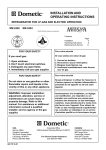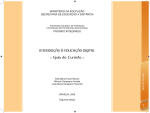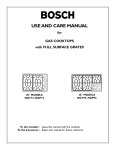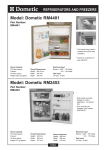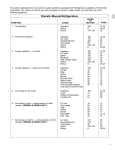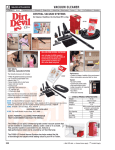Download RM2310 RM2410 RM2452 RM2453 RM2552 RM2553 RM2510
Transcript
SERVICE TIPS Efl Dometic@ MANUAL REFRIGERATORS Models RM2310 RM2410 RM2452 RM2453 RM2552 RM2553 Copyright 1996 The Dometic Corporation RM2510 RM2610 RM2810 OS1717 4/96 THE MOST COMMON SYSTEM PROBLEMS ASSOCIATED WITH THE RM2310, RM2410, RM2510, RM2610 , RM2810, RM2452, RM2453, RM2552 AND RM2553 REFRIGERATORS SYMPTOM No operation. 1. CAUSE Operation Wiring Switch 2. No electric operation. Operation AC Volts Heating Element Thermostat Switch Wiring 3. No gas operation - no spark. Operation DC Volts Igniter Electrode High Voltage Cable Switch Wiring 4. No gas operation - sparks but no flame. Operation LP gas Filter Orifice Burner Shut-off Valve Safety Valve Thermocouple Thermocouple Adapter, (Top Mount Controls Only) 5. Operation Level Ambient Temperature Cooling Unit No cooling on any mode. 6. No cooling on gas - cools properly on other mode(s). LP Gas Thermostat Filter Orifice Burner Flue Baffle Flue Tube 7. No cooling on electric - cools properly on other mode(s). AC Volts Heating Element Thermostat Switch Wiring SYMPTOM CAUSE 8. Insufficient cooling on all modes. Operation Level Ventilation Ambient Temperature Air Leaks Thermostat Cooling Unit 9. Insufficient cooling on electric - cools properly on other mode(s). AC Volts Heating Elements Thermostat 10. Insufficient cooling on gas. Cools properly on other mode(s). LP Gas Pressure Thermostat Filter Orifice Burner Flue Baffle Flue Tube 11. Freezes on electric - cools properly on other mode(s). Thermostat Wiring 12. Freezes on gas - cools properly on other mode(s). Bypass Screw Thermostat 13. Won’t stay lit on gas. LP Gas Safety Valve Thermocouple Thermocouple Adapter, (Top Mount Controls Only) Flame Failure Meter (Top Mount Controls Only) Flue Baffle Flue Cap (Bottom Mount Controls Only) Orifice Burner 14. Rapid formation of frost. Food Storage Air Leaks Interior Liner Seal to Frame High Humidity 15. No DC operation - cools properly on AC and gas. DC Volts Heating Element Switch Wiring Relay (RM261O/RM2810) 16. Insufficient cooling on DC- cools properly on AC and gas. DC Volts Heating Element Relay (RM2610/RM2810) 17. RM2510/RM2610/RM2810 On gas mode, sparks while flame is lit. Electrode LP Gas Bypass Screw Filter REFRIGERATORS WITH BOTTOM MOUNT CONTROLS Refrigerators with Piezo lgnitors (RM2310 & RM2410) Refrigerators with Automatic Reigniters (RM251O/RM261O/RM2610) A - ON/OFF Switch B - Thermostat Gas/Electric c - Safety Push-button D - Piezo lgnitor E - Flame View Port A B c E - - - ON/OFF Switch Thermostat, Gas/Electric Safety Push-button Light GAS OPERATION Refrigerators with Piezo lgnitor (RM2310 & RM2410) To start the refrigerator, turn knob “A” to the “GAS” position. Turn the thermostat knob “B” one-quarter (l/4) of a turn from the “OFF” position. Push button “C” in until it bottoms out-and hold. While holding button “C”, push button “D” for the piezo ignitor several times to light the burner. This can be observed through the flame view port, “E”, on the refrigerator. After the flame lights, continue to hold button “C” for an additional fifteen (15) seconds. Release the button “C” and check the flame view port “E” to make sure the burner does not go out. If the burner goes out, repeat the lighting procedure. To shut off the refrigerator, turn Knob “A” to the “OFF” position. Refrigerators with Automatic Reigniters (RM2510/RM2610 /RM2810) To start the refrigerator, turn knob “A” to the “GAS” position. Turn the thermostat knob “6” one-quarter (l/4) of a turn from the “OFF” position. Push button “C” in until it bottoms out-and hold. When lamp “E” stops flashing, hold push-button “C” an additional 15 seconds. Release button “C”. If the lamp “E” starts to flash again, repeat lighting procedure. If flame blows out, the reigniter will automatically relight the flame. 4 NOTE: After changing an LP tank, or after a long shut off period, the gas line is likely to be filled with air. You may have to repeat the lighting procedure several times to purge the air out of the gas lines. ELECTRIC OPERATION Check to be sure the power cord is properly connected to the power supply. If the refrigerator is equipped for 12 volt DC operation, the tow vehicle engine should be running to prevent discharging the battery. Turn knob “A” to the position marked “ELEC” for 120 volt AC operation or “12V” for 12 volt DC operation. Turn the thermostat knob “B” one-quarter (l/4) of a turn from the “OFF” position. To shut off the refrigerator, turn knob “A” to the “OFF” position. THERMOSTAT The refrigerator is equipped with a thermostat that can be adjusted by turning knob “B” to a different setting to maintain the desired cabinet temperature. “OFF” Setting of the Thermostat: In gas operation, the thermostat closes its main valve and the burner runs continuously at the bypass rate or pilot. In electrical operation, the contacts in the thermostat are open and the heating elements are off. “MAX” Setting of the Thermostat: In gas operation, the thermostat allows the burner to remain on high flame continuously. In electric operation, the heating element is “ON” continuously. The thermostat can be adjusted between “MAX” and “OFF” to obtain the desired cabinet temperature. The closer the knob is to “MAX”, the colder the cabinet temperature. The closer the knob is to “OFF”, the warmer the cabinet temperature. When the thermostat reaches the set temperature, it will cut the burner back to bypass or, in electric operation, shut off the heating element. OPERATION REFRIGERATORS WITH TOP MOUNT CONTROLS REFRIGERATORS WITH PIEZO IGNITORS: RM2452 AND RM2453 LEGEND: A Energy Selector Knob B Thermostat Knob C Flame Failure Safety Valve Push Button D Piezo lgnitor E Flame Indicator ---_-__-----m-------------v- REFRIGERATORS WITH AUTOMATIC IGNITION: RM2552 AND RM2553 GAS OPERATION REFRIGERATORS WITH PIEZO IGNITOR (RM2452 & RM2453) 1. To start the refrigerator, turn knob “A” to the “GAS” position. 2. Turn the thermostat knob “B” one-quarter (1/4) of a turn from the “OFF” position. 3. Push button “C”, push button “D” for the piezo ignitor several times to light the burner. This can be observed on the flame indicator “E”, on the refrigerator. 4. After the flame lights, continue to hold button “C” for an additional ten (10) seconds. Release the button “C” and check the flame indicator “E” to make sure the burner does not go out. If the burner goes out, repeat the lighting procedure. 5. To shut off the refrigerator, turn knob “A” to the “OFF” position. REFRIGERATORS WITH AUTOMATIC REIGNITERS (RM2552 AND RM2553) 1. To start the refrigerator, turn knob “A” to the “GAS” position. 2. Turn the thermostat knob “B” one-quarter (l/4) of a turn from the “OFF” position. 3. Push button “C” in until it bottoms out - and hold. When flame indicator “E” shows the flame is on, hold push button “C” an additional 15 seconds. Release button “C”. If the flame indicator “E” starts to move toward off, repeat lighting procedure. Should flame blow out, the reigniter will automatically relight the flame. NOTE: After changing an LP tank, or after a long shut-off period, the gas line is likely to be filled with air. You may have to repeat the lighting procedure several times to purge the air out of the gas lines. ELECTRIC OPERATION Check to be sure the power cord is properly connected to the power supply. If the refrigerator is equipped for 12 volt DC operation, the tow vehicle or caravan engine should be running to prevent discharging the battery. Turn knob “A” to the position marked “ELEC” for 120 volt AC operation or “12V” for 12 volt DC operation. Turn the thermostat knob “9” one-quarter (l/4) of a turn from the “OFF” position. To shut off the refrigerator, turn knob “A” to the “OFF” position. THERMOSTAT The refrigerator is equipped with a thermostat that can be adjusted by turning knob “9” to a different setting to maintain the desired cabinet temperature. “OFF” Setting of the Thermostat: In gas operation, the thermostat closes its main valve and the burner runs continuously at the bypass rate or pilot. In electrical operation, the contacts in the thermostat are open and the heating elements are off. “MAX” Setting of the Thermostat: In gas operation, the thermostat allows the burner to remain on high flame continuously. In electric operation, the heating element is “ON” continuously. The thermostat can be adjusted between “MAX” and “OFF” to obtain the desired cabinet temperature. The closer the knob is to “MAX”, the colder the cabinet temperature. The closer the knob is to “OFF”, the warmer the cabinet temperature. When the thermostat reaches the set temperature, it will cut the burner back to bypass or, in electric operation, shut off the heating element. The setting of the thermostat is not critical, but we recommend it be adjusted to maintain a dry frost on the cooling fins. Adjust the thermostat knob closer to “MAX” when the outside temperature becomes warm. AC VOLTAGE REQUIREMENTS The proper operating range is 100 to 132 volts. Check the AC volts at the receptacle where the refrigerator is attached. If voltage drops below 100 volts, cooling efficiency will decrease with voltage decrease. AC COMPONENTS HEATING ELEMENT To check a heating element, remove the heater leads from the terminal block and measure for proper resistance across the two leads. You should obtain the following readings, plus or minus 10%: RM2310 92 RM2410 92 RM2510 7 5 RM2610 48 RM2810 44 RM2452 69 RM2453 69 RM2552 69 RM2553 69 DC VOLTAGE REQUIREMENTS The operational range is 10.5 to 15 volts DC. Check for proper voltage at the terminal block or blocks at the back of the refrigerator. The power supply to the refrigerator must be fused. DC COMPONENTS SWITCH (BOTTOM MOUNT CONTROLS) A. Remove all wires from the assembly. For the DC mode, continuity should exist between terminals 1 and 1A and 2 and2A. (3-Way Models Only) For the AC mode, you should have continuity between 4L and 4A and 5N and 5A. RM2310 & RM2410 SWITCH ASSEMBLY DC Mode DC Mode AC Mode AC -Mode B. The RM251O/RM261O/RM2810 selector switch should be checked for continuity in the following manner. Remove all wires from the assembly. For the DC mode, continuity should exist between terminals 1 and IA and2 and 2A. For the gas mode, you should have continuity between 3 and 3A. For the AC mode, you should have continuity between 4L and 4A and 5N and 5A. RM251O/RM261O/RM2810 SWITCH ASSEMBLY Gas Mode DC Mode \ AC Mode DC Mode AC Mode Gas Mode SWITCH (TOP MOUNT CONTROLS) Remove all wires from the assembly. For the DC Mode (3-Way Models ONLY), continuity should exist between terminals 5 and 5a and 6 and 6a. For the AC Mode, continuity should exist between terminals 1 and la and 2 and 2a. For the Gas Mode (on refrigerators equipped with automatic REIGNITERS ONLY), continuity should exist between terminals 4 and 4a. RM2452/RM2453/RM2552/RM2553 SWITCH Gas Mode AC Mode 1 ‘DC Mode Gas Mode IGNITER A. MODEL RM2310,2410,2452,2453 When the button is pushed, a spring loaded striker creates a spark. If there is no resistance when pressing the button, the piezo igniter is defective. B. MODEL RM2510,2610,2810,2552,2553 Check that the switch is in the gas mode and is completing the circuit. Next, verify proper voltage at the positive (+) and ground (-) terminals of the igniter. The reading should be within one volt of incoming voltage at the terminal block. HIGH VOLTAGE Disconnect DC power at the terminal block. Remove high voltage cable from igniter. Reconnect DC power, the igniter should produce a sparking sound. ON MODEL RM2510,2610 AND 2810: With the igniter producing spark, set the meter on 20 volts DC or lower scale, connect meter leads to L and ground terminals on the igniter. The meter should read a pulsating voltage. The pulsating voltage allows a lamp to illuminate on the front of the refrigerator to advise the customer spark has been produced. ELECTRODE Do a visual inspection for cracks or breaks on the ceramic insulator. Also, verify the mounting bracket is attached properly to the electrode. Check the spark gap. It must be set at three sixteenths (3/16) of an inch and the tip of electrode above the slots in the burner. ELECTRODE TlP 10 HIGH VOLTAGE CABLE Be sure switch and igniter are good before checking the high voltage cable and the switch is in the gas mode. Disconnect DC power at the terminal block. Disconnect high voltage cable from electrode. Reconnect DC power to the terminal block. If sparking starts, cable is good. If no sparking, disconnect DC power at the terminal block and then disconnect high voltage cable at the igniter. Reconnect DC power to the terminal block. RELAY (RM261 0/RM2810 3-WAY MODELS ONLY) Verify the selector switch is on DC mode and the thermostat is NOT completing the circuit. Verify voltage is present between terminals 85 and 30. + Check for voltage between terminals 85 and 87. If voltage is present, the relay is defective. Verify the selector switch is on DC mode and the thermostat is completing the circuit. Verify voltage is present between terminals 85 and 86. If voltage is present, between 85 and 86 terminals, then voltage should be present between terminals 85 and 87. A 11 HEATING ELEMENT (3-WAY MODELS ONLY) Check the heating element with ohms resistance using a properly calibrated ohm meter. You should obtain the following readings, plus or minus 10%: 1.15 OHMS RM2310 1.15 OHMS RM2410 .82 OHMS RM2510 .67 OHMS RM2610 RM2810 .67 OHMS RM2453 .83 OHMS RM2553 .83 OHMS A continuity reading will indicate an open or complete circuit. FLAME INDICATOR METER If the millivolts from the thermocouple are 5 millivolts or more, the red needle in the meter should be in the green section. LP GAS REQUIREMENTS The LP gas pressure to the refrigerator should be 11 inches water column with half of all BTU’s of the RV turned on. With all other appliances turned off, the pressure to the refrigerator should not exceed 12 inches water column. To check the gas pressure when the refrigerator is operating, there is a pressure test housing located just prior to the orifice. - -*‘PRESSURE TEST HOUSING LP GAS COMPONENTS REFRIGERATORS WITH BOTTOM MOUNT CONTROLS SHUT-OFF VALVE To check the shut-off valve, remove and inspect for any obstructions. MANUAL GAS SHUTOFF VALVE REFRIGERATORS WITH TOP MOUNT CONTROLS / MANUAL GAS VALVE MANUAL GAS VALVE 12 FILTER A filter is located in the inlet fitting to the thermostat. The filter can become saturated and cause a restriction to gas flow. If you suspect a restriction, first verify the thermostat and bypass screw are good. THERMOSTAT LP GAS MODE The thermostat is calibrated by the manufacturer so that at mid-range the cabinet temperature should be approximately 40 degrees Fahrenheit. To check the calibration of the thermostat, place a container of water in the cabinet of the refrigerator and operate at mid-range setting until the thermostat is satisfied. Check the temperature of the water. It should be approximately40 degrees. To check the thermostat for proper g a s flow, set the thermostat to maximum and check the gas pressure at the pressure test port. It should be line pressure, between 11 to 12 inches water column. If you have less than 11 inches of water column pressure, the next step would be to shut off the gas supply and remove the bypass screw. Then install a bypass screw that does not have the small o-ring on it. Next, turn on the gas supply and take a reading. If the manometer now reads 11 inches of water column, the thermostat is defective and must be replaced. If the bypass screw test shows no change in pressure, the problem lies in the filter, the shut-off valve or the gas supply. ELECTRIC MODE On 2-way models it controls the AC heating element. On 3-way models it controls the DC heating element as well as the AC heating element. Check the thermostat for continuity. BYPASS SCREW There are three common sizes of this screw: S-17 (350 BTU), S-14 (325 BTU) and S-l 1 (300 BTU). To check the bypass screw, connect a manometer at the pressure test housing. The pressure on low flame mode should be 2 to 4 inches water column. SAFETY VALVE To check the safety valve, use a known good thermocouple and install into the safety valve. Supply flame to the tip of the thermocouple for 2 to 3 minutes while holding in on the safety valve stem. Remove flame from thermocouple tip and release safety valve stem. The safety valve should hold in for at least 30 seconds. THERMOCOUPLE It will produce 14 to 30 millivolts DC in normal operation. To check the thermocouple, use a known good safety valve and attach to the thermocouple. Next, supply flame to the tip of the thermocouple for 2 to 3 minutes while depressing the safety valve. Remove the flame and release the safety valve. The valve should hold for at least 30 seconds. If it does not hold the safety valve open for 30 seconds. THERMOCOUPLE ADAPTER The thermocouple adapter is a device that allows the flame indicator meter to read DC millivolts from the thermocouple. Remove it from its location and do a continuity test from the terminal to the center post. Continuity should exist. Next, check for continuity between the terminal and casing. No continuity should exist. BURNER It should be level and the slots in the burner should be directly below the flue tube. The burner should be cleaned periodically, at least once a year. FLUE BAFFLE It should be cleaned periodically, at least once a year. FLUE CAP - BOTTOM MOUNT CONTROLS It must be properly attached or flame outage could occur. 13 hElllV8 n ” hm11v8 n I---___’ ESSZW~/Ol8ZW~/Ol9ZWtl/OlSZWtl IO GU!YJOM SJB noA lapow all1 Jo! WeJfhp BU!J!M ayi Jad paJ!~ s! Jote~aQJla~ aqt ,QJ~A sJow7puo3 0~ au140 Jaql!a ~04 alrylsqns se ap!qaA au1 40 s!ssey3 Jo Apoq aut asn lou oa DNltllM lVNU31NI ‘kEllV3H l-IO/\ 3Cl P=lJ’=’ y3Olq leU!UJJal aY101 apeW S! UO!~3aUUO3 S!ql :(@lO *a 3a SIlOA Zl PayJEW y3Olq Il?U!WJal ayl 01 E$E?lU S! uoy3auuo3 aq1 :p ‘3 WPWI AeM-E) Jd -6nld s!ql WOJ~ 6uoJd 6u! -pUnOJ6 aql aAOUJaJ JOln3lON oa *al3sldaceJ 6uoJd aalyl papunoJ6 AlJadoJd e og I(l~)a~!p pa66nld a q PlnOyS pue SpJEZZEq y3oys ~J!F?BB UO!palOJd ~04 6nld (papunoJ6) 6UOJd-aaJqi t? L&M paddgba S! JOleJa6!JjaJ aql :UO!~tX3UuO~ 3v Sllon ()zc ‘V DNltllM lVNt131X3 SlEl13W1133d NI HItIN 3UlM ~013flClN03 -IV101 Wi’lWlXVW :9NlkllM EP# EP# EP# EP# ESSZWtl zsszwkl ESPZWH ZSPZIW 8S# 0 18ZWkl E9# 0 19ZNtl EP# OlciZWki 6E# OCPZWtl 66# OCGZWtl :SMOllOl SE! S! JOlE?Jatj!J4aJ l~nlEUJ EN.# JOi aD!l!JO SZ!S I3SJJO3 C3L(l *Jeah I2 XXI0 ISt?t3l$?? ‘I(llw!po!Jad palEal aq PlnOqS Xl!4!JO ayl 33Ult10 *leaA e aDuo y~t?al 112 ‘&xNpo!Jad paueal3 aq w-cu $1 38fll3fll~ TYPICAL 2-WAY WITH PIEZO IGNITER FOR REFRIGERATORS WITH BOTTOM MOUNT CONTROLS 1 123 VOLTS AC TYPICAL 3-WAY WITH PIEZO IGNITER FOR REFRIGERATORS WITH BOTTOM MOUNT CONTROLS 12 VOLTS DC r--Y 12 VOLTS DC +z I20 V O L T S A C -------$ 120 VOLTS AC H THERMOSTAT JUNCTION BLOCK 15 TYPICAL 2-WAY WITH REIGNITER FOR REFRIGERATORS WITH BOTTOM MOUNT CONTROLS I 12 VOLTS DC ! 16 120 VOLTS AC r 12 VOLTS DC TYPICAL 3-WAY WITH REIGNITER AND RELAY F O R R E F R I G E RBOlTOM A T O R MS O U W N I TT H C O N T R O L S 12 Volts DC ‘7 120 Volts AC I-? TYPICAL 3-WAY WITH REIGNITER FOR REFRIGERATORS WITH BOTTOM MOUNT CONTROLS 12 VOLTS DC +I2 VOLT: DC 12 VOLTS DC + ,*---, P ( ,___ cd/ y, II-: 120 VOLTS A C L PP : e + 4 12 VOLTS DC c-q -o___P + @ !1 -fiBLACK 0” GREEN GREEN/YELLOW @ 17 120 VOLTS AC l-9 TYPICAL 2-WAY WITH PIEZ0 IGNITOR FOR REFRIGERATORS WITH TOP MOUNT CONTROLS GROUND & 120 VOLTS AC ADAPTER 120 VOLTS AC O[ D @ AC @-SWITCH C-TERMINAL BLOCK @-THERMOSTAT @----HEATER 120~ @---BLACK Q-BROWN 3 - -R E D 4-YELLOW/GREEN @-+xEEN @-BL.UE @--MY 8 WHITE o- 61 lVlSOWtUHl--@ MO18 lVNIRM31~ tKuIMS-@ t131lN313tl~ 3 AOZI WV3H--@ + I 30 AZ1 -+ 1 3v SI:OA azl x! SllOA SlOtllN03 1NnOW d01 HUM StlOlVtl3Dlkl~3tJ tlOA tlOllNWk4 HUM AWM-2 lW3ldA.l TYPICAL 3-WAY WITH PIEZO IGNITOR FOR REFRIGERATORS WITH TOP MOUNT CONTROLS 12 VOLTS DC 120 V O L T S A C @-HEATER 12v DC @HEATER 120V AC C-SWITCH @-TERMINAL BLOCK (&THERMOSTAT GROUND & Q 4 + + +- 12V DC 20 TYPICAL 3-WAY WITH REIGNITOR FOR REFRIGERATORS WITH TOP MOUNT CONTROLS 12 V O L T S DC 12 120 VOLTS AC ;ROUNO *HEATER 12V oc 21 VOLTS DC OTHER LEVELING Refrigerators have a type of cooling unit that utilizes an enclosed pump tube surrounded by a solution to protect the assembly. To ensure proper leveling with these models, the vehicle needs to be leveled so it is comfortable to live in. (No noticeable sloping of floor or walls). When the vehicle is moving, leveling is not critical as the rolling and pitching movement of the vehicle will pass to either side of level, keeping the refrigerant from accumulating in the piping. VENTILATION In a proper installation there should be zero (0”) clearance surrounding the sides and top of the refrigerator to achieve proper air flow. In addition, the cooling unit should have the following clearances to the nearest surface made of combustible material: RM2310 1 INCH RM2410 1/2 INCH RM2510 1/2 INCH RM2610 1/2 INCH RM2810 1/2 INCH RM2452 0 INCH RM2453 0 INCH RM2552 0 INCH RM2553 0 INCH RM2510/ RM2610/RM2810 / RM2452/RM2453/RM2552RM2553 RM231 O/RM2410 n TURNING VANE ROM SIDE OF PATH OF AIR FLOW CLEARANCE FROM SIDE OF CLEARANCE FR COMBUSTIBLE MATERIALS AIR LEAKS Check the gasket on the doors to be sure of a positive air seal. Check that the cooling unit is installed properly. 22 DOOR POSITION To correct an alignment of the door, loosen the hinge screws slightly, and reorient the door in the proper position. If the door needs more adjustment than is available through the hinge adjustment, the base can be repositioned to reorient the door. AMBIENT TEMPERATURE As the ambient temperature increases, the air temperature in the area of the cooling unit increases. COOLING UNIT To check the cooling unit, first verify the AC heating element is good. Then place approximately one gallon of water inside the refrigerator and place a thermometer in one of the containers of water. Supply 115 volts direct to the AC heating element and operate for at least 12 hours. Check the temperature on the thermometer. It should be at 45 degrees or lower depending on test conditions. FOOD STORAGE Rearrange your foodstuffs. It is essential that the shelves are not covered with paper or large storage containers. Always remember to allow for proper air circulation. Odorous or highly flavored foods should always be stored in covered dishes, plastic bags or wrapped in foil or waxed paper to prevent food odors. Vegetables, lettuce, etc., should be covered. NEVER PUT HOT FOOD INTO THE REFRIGERATOR. HIGH HUMIDITY High humidity may cause a small amount of condensation to form on the frame of the refrigerator. As the humidity is reduced, the sweating will decrease. INTERIOR LINER SEAL TO FRAME There is a seal that is applied to the liner in the area where the metal frame makes contact with the interior liner. Cold air can migrate out to the metal frame. Clean the metal frame and foil-backed insulation around the refrigerator. Apply a foil-backed adhesive tape to the joint between outer frame and foil-backed refrigerator insulation. Make sure the refrigerator is dry and that the surface temperatures are above 50°F. Use a clear silicon caulking compound and seal the seam between the refrigerator’s plastic liner and the metal frame. NOTE: TO FORM A PROPER SEAL, IT IS IMPORTANT NOT TO LEAVE ANY GAPS. DOUBLE DOOR REFRIGERATOR SHOWN WITH DOORS REMOVED 23























